Keyboard synthesizers are great for a massive range of sounds, from unique textures and flexible sound design to classic basslines, gigantic pads, and catchy leads. So, for keyboard players who might have their eyes on a synth or seasoned synth players and studio owners, we’re running through our list of the best synthesizer keyboards.
If you’re looking for an instrument to play on stage or something for a home or professional recording studio, look no further!
In a hurry?
Here are our top three synths and why we like them:
| ASM Hydrasynth | Flexible virtual analog and wavetable synth with high-quality polyphonic aftertouch keyboard. | Check the current price |
| Arturia Minifreak | Unique hybrid synth with algorithm-based oscillators and intuitive modulation matrix. | Check the current price |
| Sequential Trigon-6 | Premium analog poly synth with ladder filter with a blend of modern and vintage features. | Check the current price |
Why we’ve chosen these synths
There are so many different things you can get out of a synth, depending on the features and design of it. Here, we’ve tried to cover the widest range of these to help give you an idea of what might suit your needs.
From monophonic to polyphonic, digital, hybrid, and analog alike, we have picks for both beginners and experienced players that offer great value at any price point you might be looking at.
The best synthesizer keyboards on the market today
1. Arturia Minifreak – The best hybrid synth
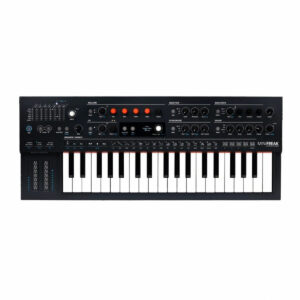 Key features
Key features
- Six-voice polyphony
- 37-note velocity-sensitive slim-key keybed with aftertouch
- 22 oscillator modes
- Two LFOs per voice
- 256 factory presets and 256 user slots
Pros
- Flexible hybrid synth capable of creating convincing analog emulations and unique digital tones alike
- Velocity sensitivity and aftertouch on keys provide expressive playing
- High-quality effects engine to add depth and polish to your sounds
Cons
- Mini keys and smaller format may not suit some players live
The Arturia Minifreak is a hybrid polyphonic synthesizer that builds on the success of the paraphonic Microfreak.
This compact six-voice synth features slim keys, which might not suit piano and keyboard players who are discerning about the feel of the keys, but it’s very playable, saves space, and still offers velocity and aftertouch. And it’s great in the studio thanks to its companion plugin, Minifreak V, which lets you bring your sounds into your DAW for production sessions, or load things you’ve made onto the hardware before playing live.
Pairing up two extremely left-field digital oscillators with 22 different modes and a multi-mode analog filter, the sound of the Minifreak tends to lean towards the… well, freaky. It’s great for creating strange sounds that you probably wouldn’t be able to achieve with more conventional hardware synths, owing to its unique oscillator modes.
Some of these oscillator modes were made in collaboration with Eurorack companies Mutable Instruments and Noise Engineering, which explains their distinct sound palette. However, thanks to a rich effects section, some more traditional oscillator modes, and the filter, you can also get some surprisingly classic analog-style sounds out of it with a little thought.
The modulation matrix of this hybrid synth is fast and immediate, making it incredibly beginner-friendly. Its modulation options offer two LFOs with custom shapes that let you adjust all kinds of parameters to create your patches, as well as a cycling envelope for extra movement.
Its sequencer is fast, intuitive, and allows you to sequence modulations. To round out this synth, you have a great-sounding stereo effects section with three slots to add those final touches to your patches. In all, the Minifreak might seem like a weirdo on the surface, but its functionality goes deep enough to deliver in all directions, traditional and experimental, live and studio.
2. Arturia Astrolab 88-Note Stage Keyboard – The best hammer-action keyboard
 Key features
Key features
- 1,600 onboard presets
- Hammer-action keybed
- 10 sound engines
- Built-in arpeggiator, looper, and modes for Chords and Scales
- Bluetooth, WiFi, USB and MIDI connectivity
Pros
- Realistic piano-like feel and response
- Seamless integration with Analog Lab Pro
- Extensive preset library and sound expansion
Cons
- Size and weight may hinder portability
The Arturia Astrolab 88 brings studio-grade sound design into a performance-ready format. Its full-sized Fatar TP-40 hammer-action keybed mimics the resistance and feedback of an acoustic piano, supported by triple sensors and channel aftertouch for expressive control. This means that whether you’re playing delicate passages or dynamic lead lines, the keyboard response remains fluid and natural.
What sets the Astrolab apart is how effectively it bridges the gap between the studio and live stage. It arrives loaded with ten sound engines and over 1,600 presets, ranging from vintage synths to iconic organs and pianos. You can also expand the library further using the Sound Store or sync your own patches via its mobile app and companion software.
The recent firmware update adds six new instruments and nearly 300 presets, sharpening the instrument’s versatility. And with a circular display, rotary encoder, and macro controls, tweaking sounds mid-set is straightforward. Its ability to store quick-access favourites and its robust effects section round out a feature set built for real-world musical demands.
3. ASM Hydrasynth – The best polyphonic aftertouch synth
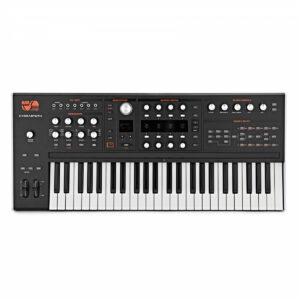 Key features
Key features
- Eight-voice polyphony
- 49-note velocity-sensitive keybed with polyphonic aftertouch
- Touch-sensitive ribbon controller
- Five LFOs and 5 envelopes for modulation
- Three oscillators per voice with 219 waveforms
Pros
- Digital synthesizer with virtual analog, FM, and wave morphing capabilities
- Polyphonic aftertouch makes your playing extremely dynamic
- Five LFOs, five envelopes, and two filters give you plenty of sound-sculpting options
Cons
- Deep engine may be intimidating to users less familiar with synthesizers
The ASM Hydrasynth is a digital powerhouse designed for FM and virtual analog sounds.
Its full-size keybed is both highly playable for seasoned synth aficionados and newcomers while being incredibly expressive thanks to an uncommon feature – polyphonic aftertouch. For anyone not in the know, this means you can adjust or even modulate parameters based on how deep you press into a key, allowing you to shift notes in chords as you hold them continuously!
And as a proud owner of the miniaturised Hydrasynth Explorer, I can confirm that this is a very cool feature that you can get lost in for a long time.
The Hydrasynth’s engine can sound quite digital, but it has a wide range of more traditional waveform and modulation options that can let you unlock more vintage tones once you work around some of the more digital elements.
With features like filter drive, warm mode, an expansive effects section, and per-voice modulation, this can go from ’80s-tinged digital FM pads to big, brassy analog-inspired strings. This digital synth quickly becomes more of a sonic chameleon than anything.
The Hydrasynth’s wave morphing oscillators offer a lot of flexibility that expands it far beyond the expectations of even a wavetable synthesizer. Its signature mutators provide a lot of extra ways to warp, stack and move the oscillators too. Plus, four effect blocks, with pre-effects, delay, reverb, and post-effects let you flesh out any sound.
Its modulation is plentiful too, with a whopping five LFOs and envelopes to set up, with cycling and one-shot modes, it’s easy to see why this has become a studio favourite for sound designers and a go-to for touring acts.
4. Moog Subsequent 25 – The best bass synth
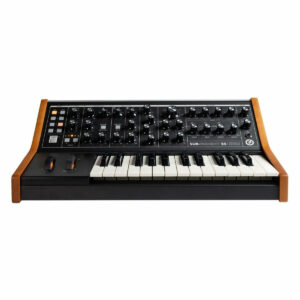 Key features
Key features
- Mono and duo phonic analog synthesizer
- 25-key velocity-sensitive semi-weighted keyboard
- Two oscillators plus sub-oscillator and noise generator
- 16 presets
- Moog ladder filter with adjustable slope
Pros
- Powerful mono and duophonic analog synthesizer excels at huge basses and leads
- Famed ladder filter with switchable slope and multidrive for gritty distortion
- 16 preset slots for fast and easy sound storage
Cons
- Limited voice count might not suit every player’s needs
Moog is a brand that has its history tied to that of synthesizers as a whole. Founder Bob Moog’s innovations throughout the ’60s and ’70s were instrumental in getting synthesizers recognized the world over.
From their famed modular systems used by composers like Wendy Carlos, Giorgio Moroder, Delia Derbyshire, John Carpenter, and even Hans Zimmer to this day, Moog also developed perhaps the most famous monophonic synth, and one of the most recorded of all time – the Minimoog. Recognised for their powerful oscillators and smooth ladder filter, their instruments just sound great.
The Subsequent 25 is not a Minimoog, however, its heritage and form factor strike me as a nod to the Minimoog with modern features and architecture. Its duophonic design lets you play two notes at once, great for interplay between leads and bass, or creating shell chords. The classic ladder filter is still here, now with an adjustable slope which adds a great deal of flexibility to your sounds.
The Subsequent 25 is a trimmed-down, but no less powerful, version of the Subsequent 37, with a quality 25-note keybed that makes it really comfortable to bring on stage or keep on your desk or synth stand.
The main highlight of this synth is just how gigantic it sounds. Three oscillators, a primary, secondary, and sub oscillator are great for massive basses and sharp leads. And the multidrive adds a powerful distortion to let you really push any sound system you’re going through to its absolute limit. If you want raw analog power for bass and leads, this one’s a no-brainer.
5. Korg Opsix MKII – The best FM synthesizer
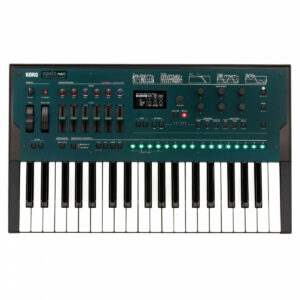 Key features
Key features
- 64-voice polyphony
- 37-key velocity and release-sensitive keybed
- Six operators, one filter, three EGs, three LFOs, three effects, step sequencer, and arpeggiator
- 40 preset and 1 unique user algorithm per patch
- 21 oscillator waveforms, 11 filter types, and 23 LFO waveforms
Pros
- Extended FM synthesizer for creating a wide range of digital tones and textures
- Six operators and 40 algorithms provide a stunning number of sound possibilities
- Extended polyphony and redesigned user interface make it even more playable than MKI
Cons
- FM synthesis can be hard to wrap your head around
A little while ago, I was lucky enough to get the opportunity to review the original Opsix, and I came away feeling quite positive about it. This FM synth is a masterclass in interface design, but isn’t for the faint of heart and I’d recommend it more for experienced synth users as the ideas of FM synthesis can be very tricky for new players to get to grips with.
That said, if anything could make FM easy to understand, it’s the Opsix.
The Opsix – as the name suggests – has six operators, which can be freely switched between uses as carriers (sound sources) or modulators. This lets you achieve a wide range of distinctly digital FM sounds, but these can go from clean and glassy to abrasive and complex.
The Opsix has a great deal of flexibility in its operators, letting you switch between algorithms, set up feedback loops between operators, or even letting you stack all six operators as standard virtual analog oscillators for more traditional synth tones.
This FM synth really shines at the fringes of sound, making it well-suited to things like ambient music, industrial music, and cinematic scoring for film, TV, or video games. Naturally capable in just about any style or sonic palette you want to work in, the Opsix has six synthesis modes: subtractive, semi-modular, analog modelling, waveshaping, additive, and FM.
It also has a fast and responsive modulation matrix that provides three envelopes, three LFOs, and 12 virtual patch-points for modular-inspired textures you can’t usually get in traditional subtractive designs. Rounded out with a huge range of filter modes and analog-modelled filters from Korg’s classic MS-20 and PolySix, and a studio-quality effects section, the Opsix is well and truly a sound designer’s dream.
New to the Opsix MKII is an expanded polyphony of up to 64 voices at once, allowing for even larger chords and sequences as well as some tweaks to the visual design of the interface to improve visibility.
The Opsix MKII has a three-octave keyboard, which may be fewer than many players might want for a live poly synth. Plus its complexity and lightweight chassis make it better-suited as a studio tool, but what a studio tool it is!
6. Moog Matriarch – The best semi-modular synth
 Key features
Key features
- Mono, duo, and four-note paraphony
- 49-note Fatar keyboard with patchable velocity and aftertouch
- Four oscillators with selectable waveforms, hard sync, and white noise generator
- Dual filters with fixed 24 dB per octave low-pass ladder, and switchable 24 dB per octave low-pass and high-pass ladder with series, parallel and stereo low-pass operation
- Two LFOs, two ADSR envelopes, two VCAs, and 49 patch points
Pros
- Semi-modular analog synth provides a flexible and patchable sound that harks back to huge synth walls of the ’60s and ’70s
- Four oscillators provide up to four notes of paraphony for chords, textures, bass, and leads alike
- Stereo VCAs, dual filters, and stereo analog delay provide a unique level of width and spatial experimentation
Cons
- Semi-modular design means it can’t save or load patches and would be fiddly to dial in sounds live with patch cables etc.
As mentioned when discussing the Subsequent 25, Moog’s history covers some very legendary synth designs, and few are rarer and more coveted than their early modular systems from the 1960s and ’70s. The Matriarch is a very intentional homage to the modules that made Moog famous.
Every section within the Matriarch is built with recreations of famed Moog modules to put the sound of their earliest designs into the chassis of a semi-modular keyboard synth.
With oscillators derived from the Minimoog to LFOs, VCAs, envelopes, and a mixer taken directly from their modular systems, the Matriarch is packed with the personality of vintage synths – with a twist. It boasts fully stereo operation thanks to its dual VCAs and filters, further supported by a stereo analog delay effect to add character and emphasise this sense of space.
The Matriarch delivers a rich, warm sound with extremely flexible semi-modular routing that makes it an undeniable studio powerhouse. Great for deep basses, duophonic interplay of leads and bass, thick arpeggios, or textured chords and sound design, this is an unmistakable sound updated for the modern musician.
With two LFOs, two envelope generators, and modular multiplier with 49 patch inputs, modulation is easy and flexible, allowing you to route things in ways that classic subtractive synths don’t tend to offer. Its fully analog semi-modular design means there’s no patch storage, and patching live can be a challenge in itself, but it’s excellent for performers willing to lean into these parts of the Matriarch’s architecture.
7. Nord Wave 2 – The best performance synthesizer
 Key features
Key features
- 48-voice polyphony
- 61-key keyboard
- Up to four layers per patch
- Four oscillator modes: virtual analog, wavetable, four-operator FM, and sample
- 16 banks of 25 layerable single sounds for 400 total presets
Pros
- Analog-modelling performance synth with four oscillator modes
- Four layers per patch let you stack, blend, and perform several different sounds at once
- Sample engine provides the possibility to layer all kinds of other instrument sounds
Cons
- Engine isn’t suited to deep sound design or anyone seeking an instrument with its own personality
The Nord Wave 2 is designed for performance above anything else. Let’s be honest, you’ve seen Nord keyboards on-stage before, the distinctive red chassis, sleek interface, and unique curved typeface have graced stages for a huge number of artists and bands.
This digital synthesizer, in particular, offers four editable layers and a broad range of tonal flexibility. With an intuitively designed interface and the ability to stack and layer up to four tones to your taste with shared or separate keyboard zones, the Wave 2 is simple, fast, and direct.
It also allows for virtual analog, wavetable, FM, and sample sound engines that make it easy and capable of creating pretty much any sound you could hope for. An extensive effects section, a range of filters, and two LFOs per layer – one with flexible routing and one fixed to oscillator pitch make for a synth engine that isn’t particularly deep, but very adaptable. In short, it’s a complete all-rounder.
The Nord Wave 2 probably doesn’t offer much in terms of a unique or distinctive character for synthesists seeking a specific sonic personality or a deep engine they can get lost in, but it can bend to your will to make great sounds very quickly.
With its premium 61-key keyboard, the Wave 2 feels great to patch and play. Equally as at home in the studio as it is on-stage, the Wave 2 is built with performance in mind above all else, but that can be a benefit in any setting!
8. Novation Bass Station II – The best compact mono synth
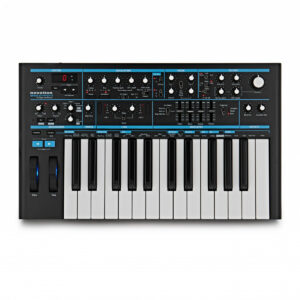 Key features
Key features
- Analog mono synth with up to three-voices of paraphony
- Full-size 25-key keyboard with aftertouch
- Two oscillators and sub-oscillator
- Two LFOs, up to two envelopes, and arpeggiator
- Two multimode filters with two switchable slopes
Pros
- Analog mono synth designed to deliver huge low-end
- Two LFOs, two envelopes, and arpeggiator provide plenty of flexibility for mono sounds
- Analog effects section with distortion, ring modulation, and filter modulation
Cons
- 25-key keybed may be limited for some players
Believe it or not, the Novation Bass Station II is made with one thing in mind: bass. As a digitally-controlled analog synth, the Bass Station II offers some of the best value for money as an analog mono synth with stable tuning and patch storage.
The Bass Station II delivers huge power and punch between its two oscillators and sub-oscillator. And while its name gives away its biggest strength, it has enough flexibility to create searing leads, arpeggios, and even drum sounds or paraphonic pads too.
Modulation is simple, direct, and easy, with multiple LFO waveforms, multiple destinations, and adjustable modulation depth to create plenty of movement. The Bass Station II’s all-analog effects section has distortion, ring mod, and oscillator filter modulation for FM-like sounds, giving it plenty of aggression and punch.
The Bass Station’s filter offers two main types – classic and acid, to get screaming acid basslines or classic mono sounds, with a filter overdrive for extra bite.
To add further flexibility, Novation collaborated on new firmware alongside legendary producer Aphex Twin to create the Bass Station II’s AFX mode, which lets you store separate patches per key and save this as a singular preset! This makes the Bass Station II great at soundscapes or even used as an analog drum machine.
Powerful and flexible enough for studios while being incredibly compact and playable thanks to its full-size keys and patch storage, this is an ideal mono synth for any setting.
9. Yamaha MODX8 Plus – The best sampling synthesizer
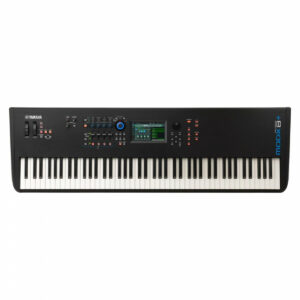 Key features
Key features
- Digital FM and sampling synthesizer
- Polyphony of up to 128 notes
- On-board memory of 1.76 GB and Waveform ROM of 5.67 GB
- 88-key hammer-weighted keyboard
- 5120 library performances, 2048 user and library live set slots, and 10,239 arpeggios
Pros
- Polyphonic FM and sampling synthesizer capable of creating any sound you need to perform with
- Hammer-weighted 88-key keyboard provides a piano-like playing experience
- Expansive on-board memory for storing patches, waveforms, libraries, and arpeggios
Cons
- The depth of the sound engine and hammer-weighted keyboard may be difficult for beginners
The Yamaha MODX8 Plus is an FM and sampling synthesizer from the company that first produced FM synthesizers and popularized them with the DX7. This is a deep synth that offers a lot of performance-ready sounds and features.
Allowing up to four layers of FM synth sounds and sample sounds, this titan of a synthesizer features Yamaha’s FM-X and AWM2 engines for accurate recreations of real-world instruments as much as synthesizers. Organ sounds, pianos, brass, violins, cellos, woodwinds, you name it, the MODX8 Plus can do it and layer it with three other parts.
Its 88-key keyboard is graded and hammer weighted, giving you the feel of a real acoustic piano – a rare feature for a synth, with heavier keys in the lower octaves that get lighter with the higher notes. This makes it excellent for performance, giving it an authentic feel that’s great for pianists and experienced keyboard players or those who want that feel to play the piano with.
A polyphony of 128 notes then ensures you have enough for even the most demanding layering and large chords without voice stealing.
The MODX8 Plus also has a vast range of performance controls, such as faders and encoders that let you set up or perform automation of certain parameters. The highlight of these is the Super Knob, which can control a huge number of things simultaneously to add constant movement and evolution.
Plus, an integrated USB audio interface is ideal for both recording and performance. For working keyboard players who want a complete all-rounder solution, the MODX8 Plus may just be the perfect choice.
10. Sequential Take 5 – The best all-rounder
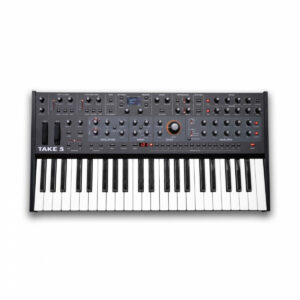 Key features
Key features
- 5-voice analog synthesizer
- 44-key velocity-sensitive keybed
- Two LFOs with one polyphonic per-voice LFO for complex modulation
- One selectable effects engine and one fixed reverb effect
- 256 programs for storing and loading patches
Pros
- Five-voice analog synthesizer with vintage heritage
- Variable waveform oscillators, polyphonic LFO, and modulation matrix for deep sound design
- Overdrive, vintage knob, reverb, and flexible effect slot to create complete sounds
Cons
- Five voices may limit playing for those who love big chords
The Sequential Take 5 is a modern analog polyphonic synthesizer that takes its heritage from Sequential’s famed Prophet 5, the first-ever analog synth to have digital patch storage. With an updated and modernised synthesizer engine with constantly variable oscillator waveforms and a modulation matrix for fast and easy patching, the Take 5 is great for both current and retro-tinged sounds.
The Take 5 has a few bonuses that make it fairly unique, like a polyphonic LFO that lets you modulate destinations at rates linked to the pitch of the notes being played, an analog overdrive for some bite, and the vintage knob from Sequential’s modern Prophet 6 and OB-6 range for classic parameter offsets to add some organic movement and variation.
All of these elements together make the Take 5 extremely versatile and forward-looking while still paying tribute to the past.
Despite having a shorter keyboard than most Sequential offerings, some clever design has allowed for an extended range, with the low split function letting you set the bottom octave of the keyboard down. Rounded out with a switchable effect and a permanent reverb, as well as a 64-step sequencer and comprehensive arpeggiator, the Take 5 brings some classic architecture into the modern day at a more accessible price.
Extremely performable and studio-ready, the Take 5 is an ideal analog poly synth for those who want a vintage character in a modern and versatile form.
11. Behringer MonoPoly – The best paraphonic synth
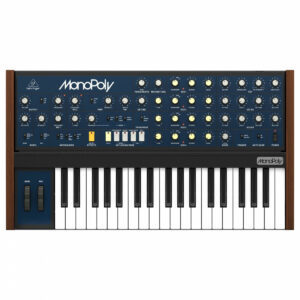 Key features
Key features
- Switchable monophonic and four-voice paraphonic synth
- 37-key velocity-sensitive keybed
- Up to two timbral layers
- Vocal processor with gooseneck condenser microphone
- 256 programs for storage and loading
Pros
- Analog synth with up to four paraphonic voices
- Four-oscillator architecture suitable for a range of sounds, from chords and pads to basses and leads
- Tiltable panel for ergonomic playing
Cons
- No patch storage means manually dialling between sounds when playing live
The Korg MonoPoly was an analog synthesizer built in 1981. A four-VCO synthesizer, the MonoPoly could be used in mono or switched to four-note paraphonic for chords. Owing to its unique filter design and four oscillators, it had a beefy sound for basslines and leads that encouraged detuned aggression, synced oscillators, and analog FM.
Plus, when split for paraphonic use, you can get some thick pads, stabs, and arpeggios.
The Behringer MonoPoly is no different, an exacting recreation of this beloved vintage synth, its heart is the same as the original, with a few modern additions.
For starters, Behringer’s recreation is smaller than the original, with a 37-key keyboard instead of a 44-key one. Plus, it has the addition of MIDI, which the original pre-dates by several years, with 5-pin and USB connectors for sending and receiving MIDI data. The MonoPoly is fast and immediate, and it grabs your attention instantly thanks to its hands-on, menu-free interface which is a rarity for synths these days!
The original MonoPoly was a favourite of Tangerine Dream, responsible for many of MGMT’s famous sounds, including that earworm lead on “Time to Pretend”, and saw use from The Chemical Brothers. It’s since found its footing with modern electronic producers like Flume, Tycho, and Apparat.
If any of these artists have the kinds of sounds you like, Behringer’s updated take on the MonoPoly is an easy recommendation, with its addition of MIDI making it great in studios, and its lighter, more compact form factor, and tiltable panel making it more performable on-stage. If you want a little more information on the Behringer MonoPoly, check out our hands-on review!
12. Korg Wavestate SE – The best digital poly synth
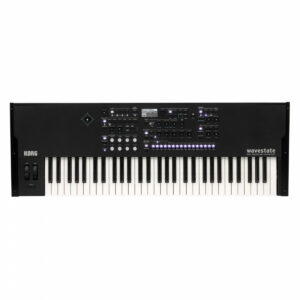 Key features
Key features
- 120-voice wave-sequencing synthesizer
- 61-key velocity-sensitive keybed
- Huge sound library with sampling engine
- Four sound layers with vector control
- 261 performances, 799 programs, and 1042 wave sequences
Pros
- Digital wave-sequencing synthesizer provides unique-sample based sounds
- Durable metal chassis and 61-key keybed
- Four sound layers with a huge range of sounds to sequence and morph between, providing unique tonal flexibility
Cons
- Heavy-duty design may be difficult to travel with
The Korg Wavestate builds on a ’90s digital classic. The Wavestation was a Korg product released in 1990 after Sequential Circuits closed and their team of designers went to Korg for work. Fresh after the release of the Prophet VS, the former-Sequential team took the ideas of digital vector synthesis and morphing waves with a joystick and added two extra layers: wave sequencing and sampling capabilities.
Wave sequencing was a unique form of digital synthesis that used short segments of waveforms that could be blended, layered, or morphed into each other to create distinctive digital sounds. The Wavestation quickly became popular for film and TV scoring due to its sampling capabilities, and was a common choice for live performances.
The Wavestate is Korg returning to the innovations of wave sequencing 30 years after its original release. Developing new waveforms, new samples, a deeper engine with more controls over the wave sequence parameters, and an updated interface to engage with all of these elements, Korg have built upon this legacy with the Wavestate series.
The Wavestate SE delivers a large-form 61-key keyboard, 120 notes of polyphony, advanced sequencing and modulation capabilities, modelled filters, and high-quality effects to update the sound of early ’90s digital synthesis for the modern day.
The updates to the Wavestate in the MKII and SE versions offer expanded polyphony, a larger sound library, high-end sounds from the Kronos and Krome workstations, as well as unique sequencing lanes. Its rugged metal chassis and large keybed enhance the Wavestate experience to recapture the experience of playing a digital classic from the early ’90s on stage whilst also being ideal as a studio centrepiece.
13. Sequential Trigon-6 – The best analog poly synth
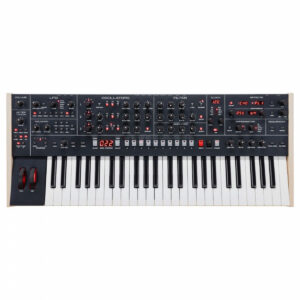 Key features
Key features
- Six-voice analog synthesizer
- 48-key velocity-sensitive keybed with aftertouch
- Ladder filter with two-pole and four-pole slopes
- Arpeggiator and sequencer
- Dual effects engines, distortion, and vintage knob
Pros
- Modern analog synthesizer with three oscillators
- Ladder filter with feedback and drive for beefy distorted sounds
- Classic Prophet-style poly-mod for vintage audio-rate modulations
Cons
- Single LFO may not offer the number of modulation options some people might prefer
The Sequential Trigon-6 is the final synthesizer ever designed by the legendary engineer Dave Smith before his unfortunate passing in 2022. Building upon Sequential’s recent 6-Series, including the Prophet-6 and OB-6, the Trigon-6 takes its architecture to new heights by being built around a classic ladder filter design with switchable slope.
Distinct from the SEM filter of the OB-6 and the Curtis filter of the Prophet-6, the ladder has been a core design of many Moog synthesizers, giving it a character all its own.
Whilst it keeps the stripped-back single-LFO modulation system of the OB-6 and Prophet-6 and keeps the Polymod section first pioneered in the Prophet 5 to expand its tonal palette, the Trigon-6 offers plenty of other features to set itself apart beyond the new filter. Primarily, the Trigon-6 is the first in the range to have three oscillators per voice, giving it a massive sound!
In addition to Sequential’s exceptional distortion circuit, vintage mode, and dual effects engine, this synth has oscillator drive and feedback, which makes the Trigon-6 really shine for not just warm vintage-inspired poly sounds but unique soundscapes that can go from gentle and ambient to harsh and experimental.
As Dave Smith’s final passion project, the Trigon-6 is an undeniably premium instrument. Its flexibility in the sound engine makes it a no-brainer for studio use, with its unique features letting it handle incidental sound design elements as much as classic poly synth sounds. With its incredible build quality and responsive keyboard, it will be extremely at home on any stage.
What to look out for in a synth keyboard
So, we’ve covered a few key products that we think would be best for live performance, but not everything is for everyone. So, in case you want to keep looking, what features should you look out for?
Polyphony
First, we’d recommend looking at polyphony. Knowing how many notes your synth can play at once is important for dictating how you perform. For example, if you just want leads and basses, a mono or paraphonic synth may offer better value and features for your kind of playing. Digital synths will tend to offer a lot more voices for the price compared to analog, as the components involved are less expensive.
If you like to play a lot of complex sounds, and a lot of notes at once, high voice counts are much better. However, if you’re absolutely in love with the sound of analog, it’s still worth considering the available voice count. Just don’t expect anything like the 120-voices of the Wavestate SE!
You’re more likely to find polyphony of somewhere between six and 16 in an analog synth, the highest polyphony of an analog synth on our list here was six!
Keys or sequencer?
It’s also worth considering the number and style of keys on your keyboard. For example, I tend to use mini-keys for studio work, but for live playing, I’d much prefer to use a full-sized keyboard. Your budget might not always make this an option, but if you’re unhappy with how a keybed on a synth feels for performing, acquiring a MIDI controller with larger and more comfortable keys to connect could fit your needs.
A sequencer is also a key part of live performance, taking some pressure off playing the keys for less-experienced players, or just relieving you of some of the stress of playing. Plus, a sequencer can let you create complex parts that you physically couldn’t perform with just keys. You may realise you don’t need a sequencer, and an arpeggiator or just playing the keys is fine, but it can add a lot of flexibility or evolution to sounds.
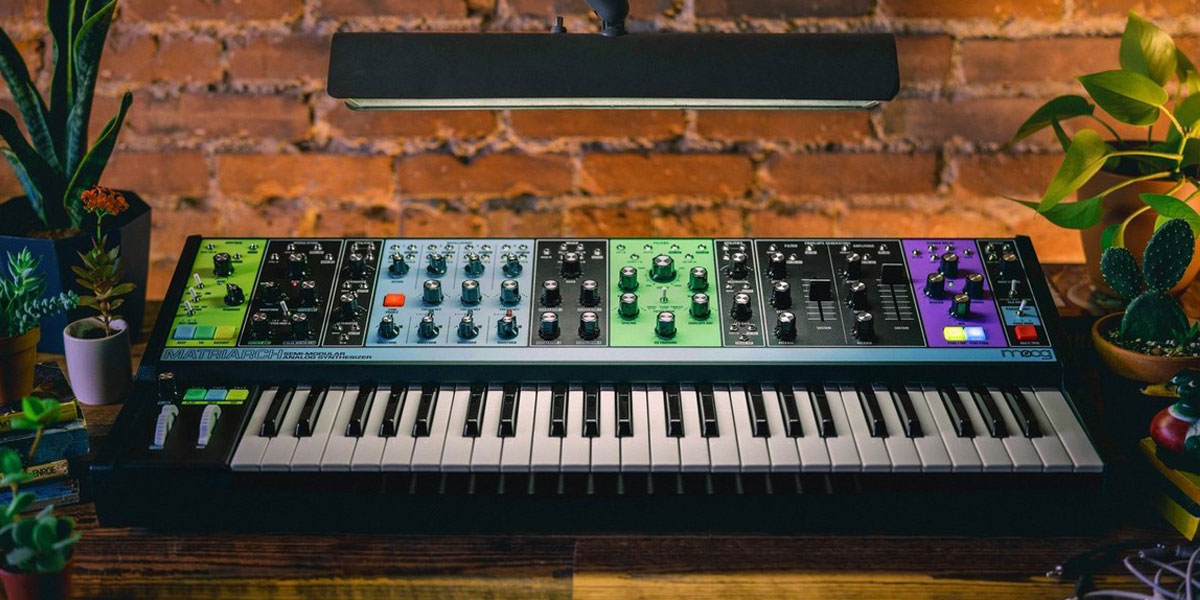
Patch storage
Patch storage is a really important element when playing live. Sometimes, you might not want nor need it, but that means you’ll have to tweak parameters manually between songs or stick to a particular sound across your set. Usually, digital synths will have patch storage. However, this case varies with analog.
A lot of classic circuits from the ’70s didn’t originally have this feature, and some mono synths may not necessarily benefit from its inclusion. So, if you have a large bank of sounds you want to switch between rapidly, patch storage will be a must-have. But for some kinds of performance, you might be able to just set up a sound you like and either change it throughout your set or between songs.
Effects
Effects are an important way of rounding out many synth sounds. Not everything needs them, of course – basses often don’t need any effects whatsoever but might be enhanced by some distortion or a delay. Pads tend to come to life with some extra effects as they may feel thin without them.
Leads sit somewhere in between; a good reverb, distortion, or modulation effect can always make them unique, but sometimes a pure lead slices through a track like nothing else.
It’s all up to your preferences, with some synth players opting to buy and use guitar pedals to fill this role – either because they use synths without any onboard effects or because they just prefer the sound and can do something the synth can’t!
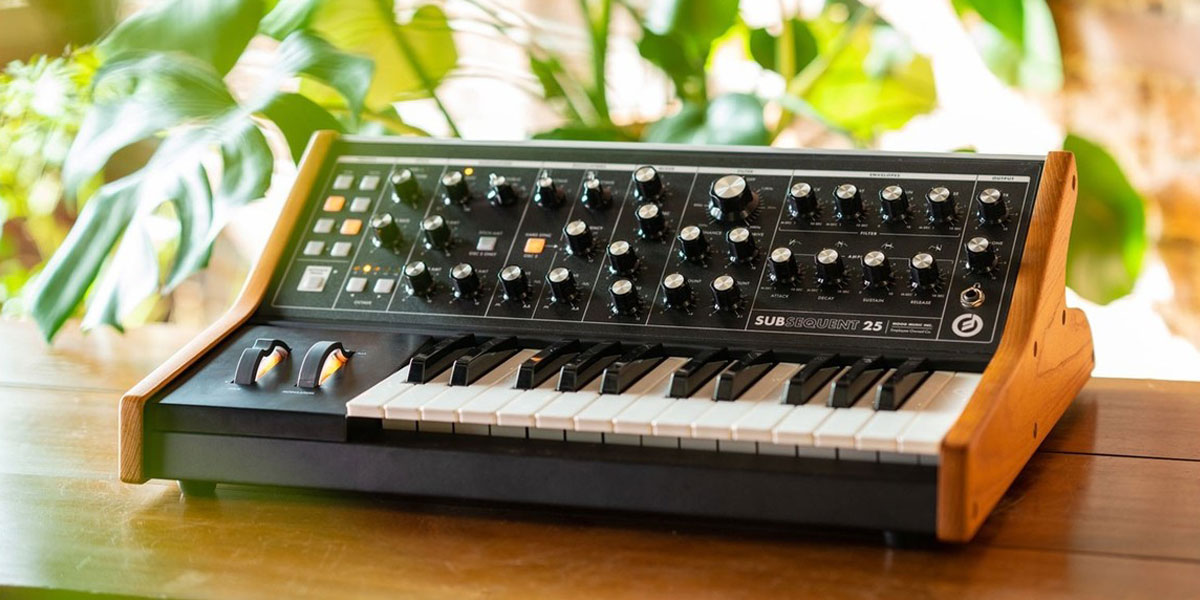
How much to spend on a synth
Let’s be honest – synths are expensive! How much you should spend is really up to the features you’re after and the way you want to play it. Do you need keys? If not, perhaps a synth module will give you the engine you want for cheaper to complement a MIDI keyboard. The more expensive a synth, the more features and the more premium the build quality will be.
Every voice of polyphony will be more expensive, keys add to the price, as do effects, sequencers, and modulation options! It’s all about deciding where you’re willing to compromise and where you’re not to get the best experience for your money and taste.
It’s possible to get beginner keyboard synths for £200, but they will likely have mini-keys and be mono, so if that fits your needs, know that’s the minimum you’re looking at going in.
What about synth plugins?
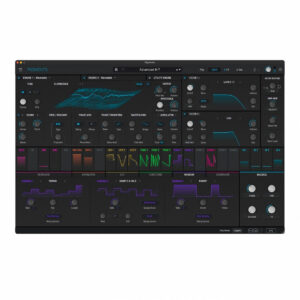 Synth plugins are usually a more affordable and accessible option for studios and performance. They pair extremely well with a MIDI keyboard but will require some form of computing to play live with – like a laptop.
Synth plugins are usually a more affordable and accessible option for studios and performance. They pair extremely well with a MIDI keyboard but will require some form of computing to play live with – like a laptop.
If you’re confident and happy to take your laptop with you, this may be a more flexible way of getting your hands on a synth. With a plugin, you can recreate the sounds of vintage synths we’d all love but struggle to find, afford, and maintain, or create unique sounds that even many hardware synths simply aren’t capable of.
Plugins usually offer increased polyphony, deeper modulation options, and expanded features like effects, or the ability to model a range of instruments.
We’d recommend Arturia’s Pigments for a complex and forward-thinking modern synth with a range of engines and capabilities. u-he’s Diva is excellent for emulating a number of different analog synths at once. And if you want a specific instrument emulation, Roland’s Cloud range and Cherry Audio’s offerings are excellent.
For more specific recommendations, check out our list of the best synth plugins!
FAQs
Who makes the best keyboard synthesizers?
There are a lot of amazing synthesizer brands, but our favourites for keyboard synths are Sequential, Korg, Moog, Novation, Arturia, Behringer, and Yamaha.
What is the best entry-level keyboard synthesizer?
There are a lot of options for a good starter synth, but our picks would be the Arturia Minifreak, Novation Bass Station II, and Korg Minilogue XD.
What’s the difference between a synthesizer and an electronic keyboard?
While synthesizers and electronic keyboards look similar, they are quite different for one main reason. A synthesizer is capable of creating its own sounds, whereas keyboards don’t.
Final thoughts
There are a lot of different considerations that go into a synthesizer purchase. Hopefully, you’ve come away from this list with a few ideas for the best keyboard synthesizer to accompany you on stage or become the workhorse of your studio.













0 Comments